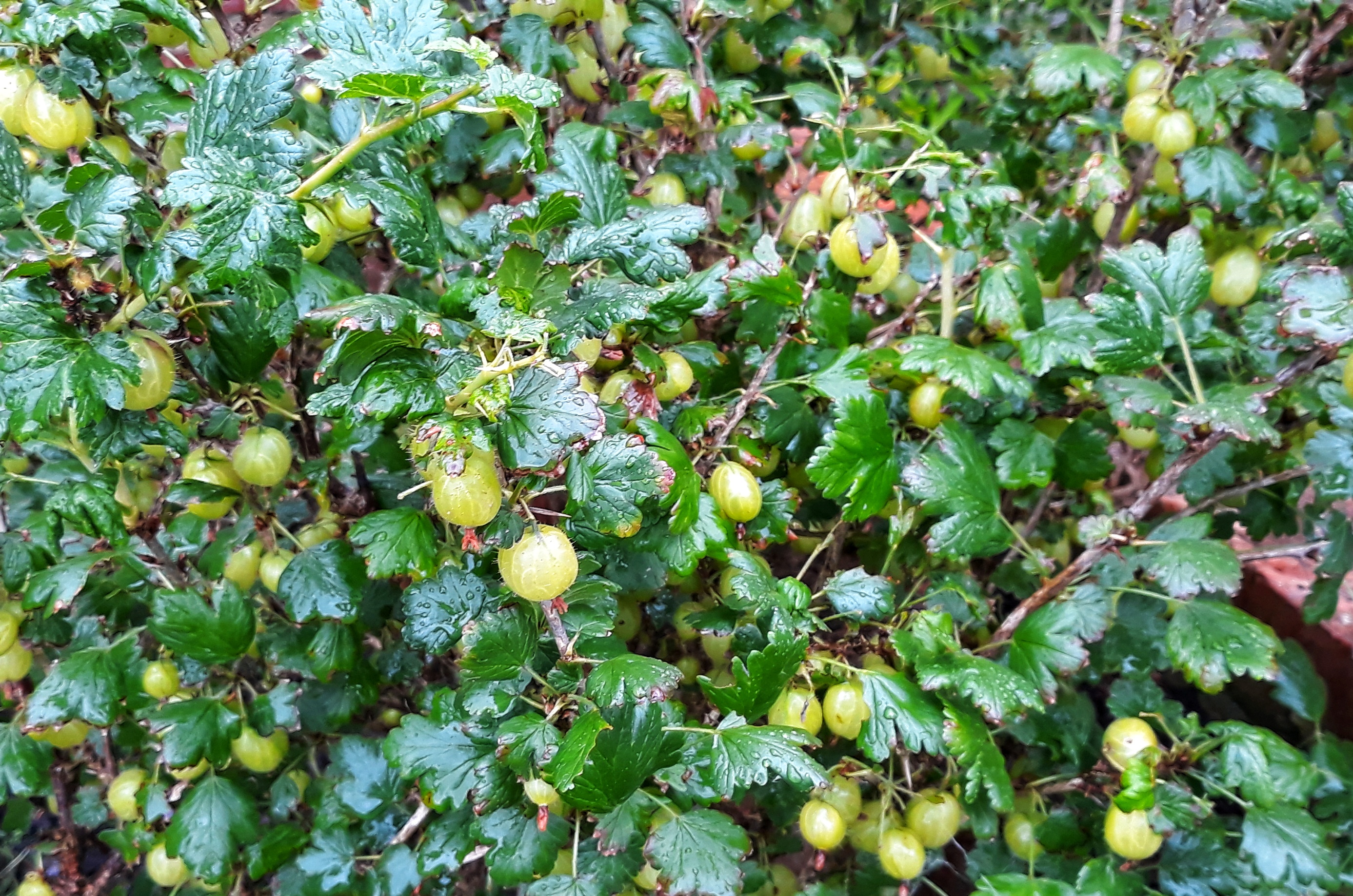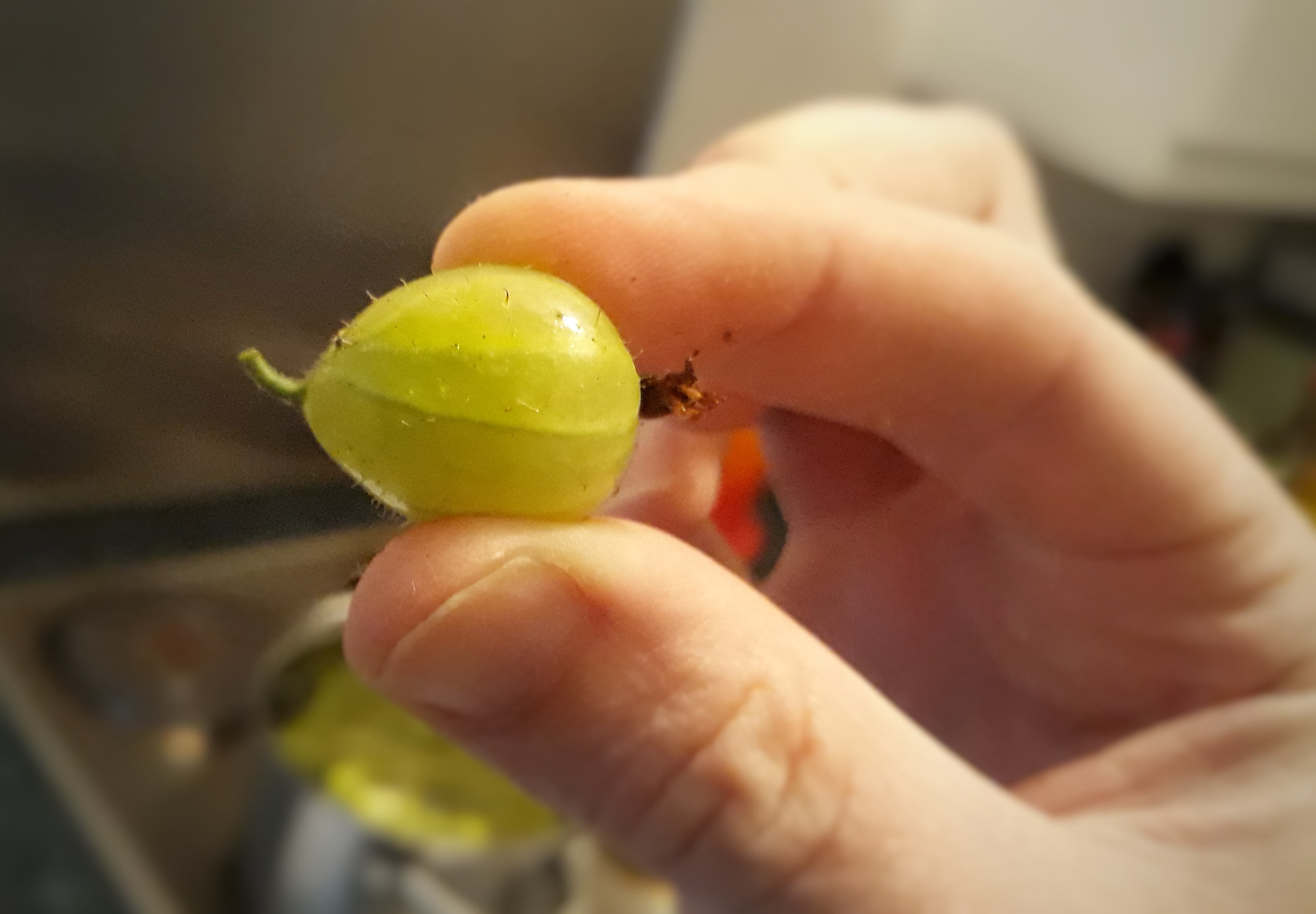‘Country life has its advantages’, he used to say, ‘You sit on the veranda drinking tea and your ducklings swim on the pond, and everything smells good…and there are gooseberries.’
Anton Chekhov, Gooseberries, 1898
The humble gooseberry is not the first of the British summer fruits that springs to mind, but it is the first of the season, and I think it should be celebrated just as much as the strawberry or blackcurrant.
It’s quite difficult to find gooseberries in the shops these days – even good greengrocers don’t seem to sell them, which is odd, because they keep better than any of our other soft fruits. I suppose one of the reasons for its unpopularity is that they are usually sold when vibrant green, looking lovely and fresh but tasting very sour and astringent. In this form they need to be cooked and sweetened with sugar. Its other disadvantage is that it usually has to be cooked, no competition amongst the huge variety of exciting dessert fruits available. It’s a crying shame. Gooseberry season starts in June, but you have to wait until July for them to ripen into dessert fruit. Patience is a virtue, after all.
The gooseberry is usually a fruit more suitable for cooking, needing considerable sweetening for palatability unless a savoury accompaniment for meat or fish.
Laura Mason & Catherine Brown, The Taste of Britain
The gooseberry is one of 150 species of the Ribes genus, which also includes the smaller and daintier black, red and whitecurrants. They can be found growing wild in patches of scrub all over Britain, so keep an eye out wherever you see such areas on walks, there may be a hidden gooseberry plant (I have my own a secret patch). Gooseberry shrubs are typically three for four feet high, and as any gooseberry forager knows, somewhat spikey.

If you like the blogs and podcast I produce, please consider treating me to a virtual coffee or pint, or even a £3 monthly subscription: follow this link for more information.
There are many cultivated varieties including two hybrids; red and white gooseberry varieties have been crossed with red and whitecurrants respectively. The hybrids make excellent dessert fruit, helpfully indicting ripeness when they’ve achieved a good ruby or white colour.
Though looked over now, gooseberries were extremely popular and have been cultivated in Britain since al least the Fifteenth Century. They were important because they were the first soft fruit of the summer, cropping well as far north as the Shetland and Orkney Islands. In the Midlands and Northern England they were revered, a tradition of competitive growing quickly developing. There was a single aim in these competitions: to grow the heaviest berry. These clubs were widespread and at one point there was 170 growing clubs, a handful still exist today in Yorkshire and Cheshire. To achieve heavy berries, by the way, you must strip your shrub of berries as soon as they appear, leaving behind a dozen so that the plant can put all its energy into growing just a few fruits.

Gooseberries are also known colloquially as feabes, feaberries, carberries and wineberries – the latter name coming from the fact they make excellent wine.
Aside from some parts of northern Europe, gooseberries haven’t really travelled much further than Britain from a culinary point of view. According to Jane Grigson, the French ‘have no name for them distinct from that of redcurrants’. This does seem to be the case; the French word for redcurrant is grosielle and when gooseberries are called for, they are called grosielle à maquereaux – the mackerel redcurrant.
Although sometimes served with goose, it is not the origin of the gooseberry’s name as you might assume. It comes from the Old Norman/Middle English groses or grosier, the old word for – wait for it – grosielle, the French for redcurrant, so in effect we called gooseberries redcurrantberries! All of these words come from the Frankish root krûsil which means ‘crisp berry’, and the gooseberry certainly is that.
Yellow and red are dessert fruit, let them lie on the hottest sunshine till warm through before serving – it brings out the sweetness and flavours.
Dorothy Hartley, Food in England
Preparing and Cooking Gooseberries
Whether you are picking them or buying them, you need to know how ripe your gooseberries are. This important because small, vivid green gooseberries are best for accompanying savoury dishes, and large riper ones are best made into puddings. I remember as a child, dipping raw, tart gooseberries straight into the sugar bowl. I expect the Sugar Police would have something to say about that these days.

To prepare your gooseberries, wash well with and top and tail them with sharp scissors or pinching fingernails.
If you have lots of gooseberries, you can do several things. Pop some straight into freezer bags or stew them with sugar, a little water and a knob of butter and freeze that. I prefer to make jam or vinegar if I’m going to preserve them. When they cook, they start to lose their colour and if boiled very thoroughly, like for jam, they attain a lovely deep pink.
Gooseberry compote is very useful; it can be served simply with ice cream for a quick dessert, or baked in the oven as a pie, crumble or cobbler. A classic dessert is gooseberry fool, simply compote folded into lightly whipped, sweetened cream, or even better a mixture of custard and whipped cream.

Other desserts include steamed puddings and a delicious baked pudding rather like an Eve’s pudding: I shall be certainly posting a recipe for that. Old fashioned pies called Oldbury tarts made with hot water pastry used to be very popular. Sometimes the pies were filled with red or whitecurrant jelly, just like an old-fashioned raised pork pie – I bet they would be great served with cheese.
I cannot talk about the culinary potential of gooseberries without mentioning elderflowers. I love their delicious sweet-musk scent and add it to anything I possibly can. Back in the days of the restaurant, I made an excellent elderflower blancmange with gooseberry compote and shortbread biscuits, and I must say it was one of the best desserts I’ve ever made.
To add an elderflower air to your gooseberry dishes simply tie up a few heads in muslin before dunking them in your gooseberries or whatever.
In the next few posts, I’ll show you some of the recipes I have mentioned above, just in case you get a glut of them or spy a punnet in the greengrocers.

I haven’t eaten a goosegog for a very long time, but I vividly remember an uncle cultivating them in the 60s and their slightly prickly skins. I’m sure my farmer was selling them on Sunday – perhaps I need to buy some…
LikeLiked by 1 person
You absolutely should buy some! I’ll be posting some recipes in the next few days (hopefully)
LikeLike
I look forward to that.
LikeLiked by 1 person
that’s good
LikeLiked by 1 person
Pingback: A Gooseberry Sauce for Mackerel | British Food: A History
Pingback: Gooseberry Jam | British Food: A History
Pingback: Baked Gooseberry Pudding | British Food: A History
Pingback: How to make Gooseberry wine – Old Timey Winey
Goosebery pie—-3 eggs (beaten) 2/3 cup milk–1 1/2 cup sugar–1/4 teasp salt—1 tsp vailla—4 cups gooseberries—3 tbs/ butter—-pinch of cinnamon. Preheat oven–In a lge bowl, beat eggs, and then add milk, sugar, salt, and vanilla– Stir well, and add gooseberries–pour into a ten inch pie shell. drizzle butter on top and sprinkle abit of cinnamon. Bake at 400 degrees, for 15 minutes. Cover, piecrust edges, with foil, and bake some more, at 350 degrees, for an additional 50 to 60 minutes.
LikeLiked by 1 person
Sounds great! Thanks Darleen
LikeLike
I love gooseberry’s🥰🥰🥰🥰
LikeLiked by 1 person
Pingback: Elderflowers | British Food: A History
Pingback: Medieval fly problems…. | murreyandblue
Pingback: Foods in Season in Georgian England: Pastor Woodford’s Dining Habits, Hannah Glasse’s Recipes and the Martha Lloyd Connection: | Jane Austen's World
Great article thank you. I have 4 bushes, which produce around 10lb in weight of Gooseberries. They are such an underrated fruit. I can’t give them away as no one likes them or has bad childhood memories of them.
LikeLiked by 1 person
What a crying shame. They are one of my favourites too
LikeLike
Pingback: Dehydrating Gooseberries -How To Dry Gooseberries In A Dehydrator Or Oven - Preserve & Pickle
Pingback: February in Jane Austen’s World | Jane Austen's World